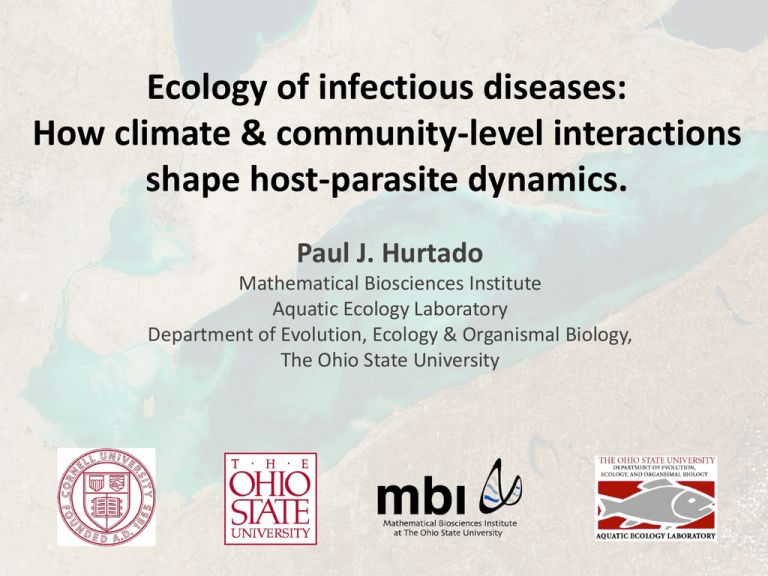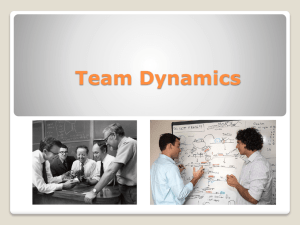Model
advertisement

Ecology of infectious diseases: How climate & community-level interactions shape host-parasite dynamics. Paul J. Hurtado Mathematical Biosciences Institute Aquatic Ecology Laboratory Department of Evolution, Ecology & Organismal Biology, The Ohio State University About Paul… About Paul… About Paul… Mathematical Biosciences Institute The Ohio State University | Columbus, OH http://mbi.osu.edu/ Aquatic Ecology Laboratory (AEL) Kinnear Rd, West Campus http://ael.osu.edu/ Part I Disease Dynamics in Consumer Populations: Consequences of Resource-Mediated Transmission and Infectiousness Acknowledgements The Daphnia Crew Spencer Hall (IU, Bloomington), Megan Duffy (GA Tech), and their labs. The Ellner-Hairston lab at Cornell Stephen Ellner, Nelson Hairston Jr., Joe Simonis, Mike Cortez, and others. Mathematical Biosciences Institute (MBI) Libby Marschall, Joe Tien, Marisa Eisenberg, Suzanne Robertson, Yunjiao Wang, Rebecca Tien, others. Others: Frank M. Hilker (Univ. of Bath) Chris Schepper (Cornell, CAM) Background Algae (n) Daphnia/host (x+y) Spores (z) Goals Typical predator-prey models driven by population size. Typical infectious disease models driven by population size. Models with both often tacitly assume only indirect crosstalk between processes, mediated by population size. The data say direct interactions exist, i.e., some disease parameters depend directly on the predator-prey interaction. Q1: How do these dependencies affect prey-predator-disease dynamics? Q2: How does density-dependent transmission give rise to instances of bistability? The Model n x y The (Simplified) Model n x y Model Comparisons Expected Dynamics? • SI (SIZ) Dynamics? • Host-Resource Dynamics? Ross’s SI Model •Ross, R. 1908. Report on the prevention of malaria in Mauritius. London. http://archive.org/details/onpreventi00rossreportrich •Ross, R. 1916. "An Application of the Theory of Probabilities to the Study of a priori Pathometry. Part I". Proceedings of the Royal Society A: Mathematical, Physical and Engineering Sciences 92 (638): 204–226. doi:10.1098/rspa.1916.0007. •Ross, R.; Hudson, H. P. 1917. "An Application of the Theory of Probabilities to the Study of a priori Pathometry. Part II". Proceedings of the Royal Society A: Mathematical, Physical and Engineering Sciences 93 (650): 212. doi:10.1098/rspa.1917.0014. •Ross, R.; Hudson, H. P. 1917. "An Application of the Theory of Probabilities to the Study of a Priori Pathometry.--Part III". Proceedings of the Royal Society B: Biological Sciences 89 (621): 507. doi:10.1098/rspb.1917.0008. Mandal et al. Malaria Journal 2011, 10:202; Fig 2. Key Insight: Epidemic Thresholds • Thresholds are criteria (mathematical inequalities) used to predict qualitative outcomes. (“Dynamical systems” terms) • Ex. Water can be a solid, liquid or a gas at sea level: Solid if T < 0⁰C, Liquid if 0⁰C < T < 100 ⁰C, Gas if T > 100 ⁰C • Ex. Allee effects for endangered species: Initial size too low, populations die out. Above threshold, populations grow. VERY common threshold in biology: Population growth or extinction determined by the average lifetime reproductive output of individuals. Greater than 1, growth, less than 1, decline. “SI” Model of Disease Transmission Assume: 1) Births = Deaths 2) This implies N=S+I constant 3) Infection is life long dS/dt = m(S+I) – βSI – mS dI/dt = βSI – mI N constant, so no need for dS/dt! dI/dt = β(N-I)I – mI dI/dt = β(N – m/β – I)I Equilibrium number infected? dI/dt = 0 “no change over time” I=0 or I = N – m/β Growth vs. decline in I? dI/dt positive or negative? 0< I < N – m/β which requires βN/m > 1 The Model n x y Consumer/Host Parasite/Disease Basic Reproduction Number Basic Reproduction Number Host-Resource Dynamics Host-Resource Dynamics Three-species Dynamics Three-species Dynamics Q1: Why bistability? Why Bistability? Simplify the model to find out! First, transform the direct transmission (3D) model by (n, x, y) –> (n, p = x+y, i = y/p) This gives, Host-Resource Dynamics Host-Resource Dynamics Host-Resource Dynamics Host-Resource Dynamics Host “Hydra Effect” Hydra Effect + Density Dependent Transmission Bistability Summary 1. Bistability arises in these models due to • • The presence of a “Hydra Effect” in the hostresource (Rosenzweig-MacArthur) model, and Transmission is density dependent. 2. Such dynamics are only likely in nature when disease mortality is strong enough to “stabilize” consumer-resource cycling. 3. Hydra effect in tri-trophic foodweb models? Three-species Dynamics Three-species Dynamics Constant vs. Resource-Dependent? Predict by Relative Sensitivity (Slope) Summary 1. Resource-dependent epidemiological processes can significantly affect disease dynamics! 2. Qualitatively, “simple” models still perform well. 3. We can (usually) predict whether resourcedependent epidemiological rates will have a stabilizing or destabilizing effect on the threespecies equilibrium using relative sensitivities. 4. New insights into other three-species dynamics! 5. New math questions! Part II Hypoxia in Lake Erie’s Central Basin: How Annual Variation In Temperature, Dissolved Oxygen Affect Fishes Paul Hurtado (OSU), Yuan Lou (OSU), Elizabeth Marschall (OSU), Kevin Pangle (CMU) & Stuart Ludsin (OSU) (Work in Progress!) Based on Hadley Centre HadCM3 climate model http://www.globalwarmingart.com/wiki/File:Global_Warming_Predictions_Map_jpg Hypoxia (Low Dissolved O2) • Worldwide water-quality problem • Hypoxia can – reduce fish growth rates and induce stress – reduce foraging success – force fish to aggregate in a 1-2m band of the water column, and – reduce availability of predation refugia. • Consequences for fish disease poorly known. • Warming climate = more severe hypoxia. Ultimate Goal Data from Lake Erie: 1987-2005 Model We model the Central Basin of Lake Erie, ignore horizontal space, dividing the water column into 24 “patches” each roughly 1 meter deep. N1 N1 N2 N2 N3 N… N24 Leave based on “patch” quality Redistribute N3 N… N24 Model We model the Central Basin of Lake Erie, ignore horizontal space, dividing the water column into 24 “patches” each roughly 1 meter deep. N1 N1 N2 N2 N3 N… N24 ∑mξiNi mфi(N) N3 N… N24 Model We model the Central Basin of Lake Erie, ignore horizontal space, dividing the water column into 24 “patches” each roughly 1 meter deep. Population Dynamics Population Dynamics Population Dynamics Problem: Quality Index ri • Movement based on r = G/μ can lead to high tolerance for high mortality rates! • Solution? Stimulus ≠ Response! r = g(G)f(1/μ) f(1/μ) 1/μ 1/μ 1/μ What next? 1. Finalize the movement model and describe the consequences of hypoxia and variation in hypoxia events annually from 1987-2005. 2. Incorporate multiple fish species with different life histories, e.g., temperature tolerances. 3. Incorporate different microparasite disease models (e.g., SI, SIR, SEI, ???). Preliminary Results • Hypoxia induced aggregation can increase disease risk. • Stress effects appear to be less significant. • Model results are sensitive to the choice of movement rule – need to get it right! • It remains unclear how T and DO variation together impact annual population dynamics. Concluding Remarks • Simple (and not-so-simple) models are essential tools for studying complex biological systems. • Plenty of room to build bridges between existing theory in ecology, epidemiology, evolution, physiology, physical processes, climate change, … Doing it right requires good data! • Biology is experiencing a massive quantitative revolution & fueling advances in math, stats, physics, computing, … all of the other sciences. Questions?





